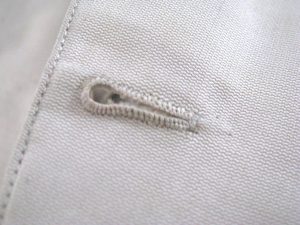The Art of the Buttonhole
Welcome to The Art of the Buttonhole! Over the next several days we will be going over each step of the buttonhole process in great detail so that by the end you’ll be able to create beautiful, historically-accurate buttonholes..

Hand-tailored buttonholes are a thing of beauty, and in the hands of a skilled tailor, can make a coat stand out amongst others. Properly sewn, they will add a level of detail that you can be proud of, yet at the same time will sit unassumingly against the background of the coat. On the other hand, a badly-done buttonhole will absolutely ruin the look of a coat, so we will be practicing on some smaller scraps of fabric meant to imitate the front of a coat or waistcoat.
To the right is an example of an 1860s buttonhole found on a cotton waistcoat, pretty much unchanged from more modern buttonholes. With a bit of care and good instruction, there’s no reason why you can’t sew a comparable one.
Plan on spending about 30 to 60 minutes each day working on the assignments, depending on your speed, and especially how many buttonholes you are working on. If you’re pressed for time, I’d work on only a couple of buttonholes and do the rest as you have time. Once you get the process down, you’ll be able to do a complete buttonhole in about 15 to 20 minutes.
This is the main page for the class, where you’ll find all of the specific lessons as they’re released.
Supplies List
- Tape Measure or Quilting Ruler
- Seam Gauge
- Beeswax
- Small embroidery-type scissors
- Tailor’s Chalk
- 1/8″ Hollow Hole Punch (usually available at hardware stores).
- 1/2″ Chisel
- Flat Board (scraps are fine, you could go as small as a couple of inches square, used to punch open the buttonholes).
- **Buttonhole Punch (As an alternative to the hollow punch and chisel. Only worth it if you are making hundreds of buttonholes on a professional basis).
- Gutermann Silk Buttonhole Twist (available in 10 yard and 437 yard spools depending on the shop. Estimate 1 to 1.5 yards per buttonhole).
- **Gutermann Buttonhole Gimp (Gives a superior buttonhole, but you can make and use four-cord instead, which is probably the better option if you’re only making a few buttonholes).
- Sewing Thread (Something on the thin/fine side I like silk thread but cotton will work too).
- Two equally sized pieces of fabric, approximately 4 – 6″ by 10 – 12″. These will be sewn together to mimic a coat front for practice. Wool, linen, and silk are all good options.
- Linen (One piece to match the size of your fabric to act as a canvas).
**Optional
Your Course Progress
[columns gutter=”0″]
[col]
[progressally_objectives]
[/col]
[col align_text=”center, middle”]
[progressally_progress_pie_chart size=”100″]
[/col]
[/columns]